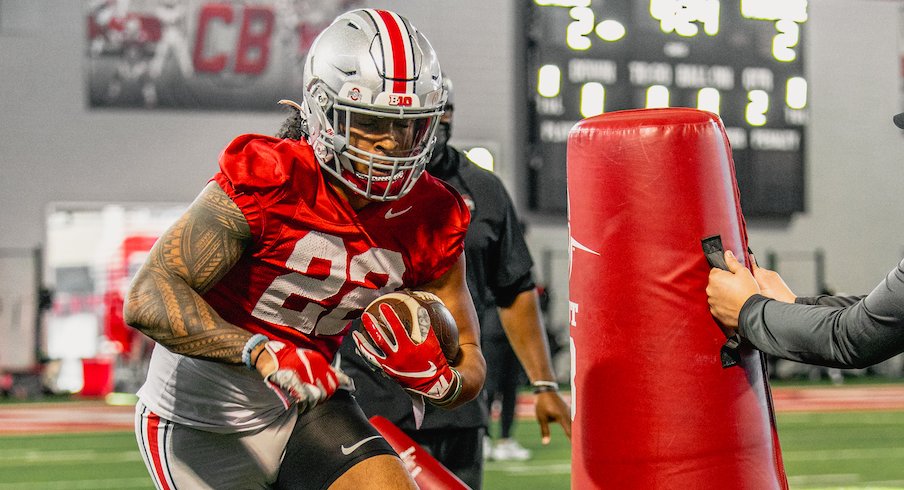Steele Chambers began his Ohio State career as a running back. He played running back his second season. And he’s going to remain a running back as he enters his third year of college football.
Ideas of Chambers potentially switching sides of the ball to play linebacker percolated in the public sphere over the past couple of months, but running backs coach Tony Alford shut the possibility down last week.
“I've heard that speculation,” Alford said on Tuesday. “I'm not sure where it came from. It didn't come out of this office. That's not something that I've had any conversation with he, his family or with coach (Ryan) Day. Steele Chambers is focused on being the best running back he can be. I'm focused on helping him become that, the best that he can be here and we'll go from there.”
The thought of Chambers ending up at linebacker stemmed from three reasons: Positional depth (or lack thereof), versatility and a minimal track record.
Unlike a year ago, when before the pandemic shut down spring camp Chambers was the only healthy running back in Alford’s room, the tailback position is jam-packed with talent. Ohio State brings back Master Teague, Miyan Williams, Marcus Crowley and Chambers and added TreVeyon Henderson and Evan Pryor to the mix. It has five or six guys imminently capable of impacting games. Conversely at linebacker the Buckeyes lost all of their top four – Pete Werner, Baron Browning, Tuf Borland and Justin Hilliard – and don’t have a single linebacker on their roster who has ever started a game. They could stand to add somebody else to Al Washington’s unit.
Chambers became a candidate in the minds of some given his background as a defensive player. He committed to Ohio State as a four-star athlete ranked 231st nationally coming out of Blessed Trinity Catholic High School in Georgia. Some schools, including Clemson, offered him a scholarship but wanted him as a linebacker. Along with his 1,500-plus rushing yards and 25 scores on offense as a senior, he had 70 tackles, including six for a loss. Chambers has spent two years developing as a tailback at the college level, but the physical gifts he has at 6-foot-1 and 220 pounds make a position switch seem at least feasible.
Plus, Chambers hasn’t done a ton yet with the ball in his hands at running back. The redshirt sophomore has 221 rushing yards and a touchdown on 28 carries across his first two years inside the program. He carried the ball just nine times last season, and he only got one touch the remainder of the year after a late-game fumble in the 49-27 win against Rutgers on Nov. 7. Chambers has had his moments, including a 38-yard scamper versus the Scarlet Knights and 17-yarder against Nebraska, but there hasn’t been consistent production quite yet.
Put all of that together, and suddenly a position switch doesn’t sound so crazy.
For now, at least, that’s not on the table. Chambers remains a tailback, vying for carries with five others in a hotly contested competition.
“We're in shorts, mind you. We're just in shorts,” Alford said. “But he's looked really good.”
At this point in Chambers’ career, there’s a sense that he needs to make something happen or risk getting passed over by younger guys. This is, for all intents and purposes, the most important offseason of his entire career.
Urban Meyer used to put the onus on the coaches for the first two years of a given player’s career before it became more of the player’s responsibility in the third year. This is Chambers’ third year as a Buckeye. It’s his time to make a name for himself.
Doing so isn’t an easy proposition. Teague’s a two-time All-Big Ten honoree and the incumbent in the room. Williams grabbed attention in the College Football Playoff. Marcus Crowley’s finally healthy. Henderson was the No. 1 running back recruit in the country. Pryor came in as a fellow top-100 prospect.
But for Chambers, with so many younger guys in the room pressing for touches, it’s bordering on a now-or-never situation as an Ohio State tailback.
“The biggest thing I want Steele to do is to exude confidence in his own self-confidence,” Alford said. “Steele's a perfectionist by nature. There are times where he can get down on himself if something doesn't go just as planned, exactly the way that he concocted the plan in his own mind. One of the things I can help him do is to continually remind him that, hey, there's a little bump in the road here, we're good. Don't get flustered. Don't let one play affect the next, meaning if he didn't do something right on this play, don't let it affect the next play and the next play. Or a lot of times he does something right and he goes, ‘Oh, that wasn't good enough.’ Hey, man, champion what you're done and where you've been.
“But he's getting better at that, so I'm anxious to see. He's had a good offseason.”


